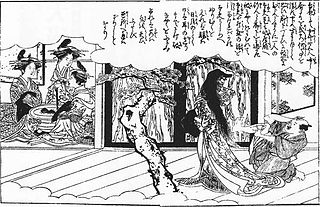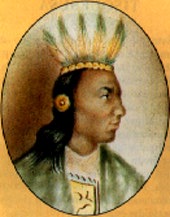La Muelona ("big molar woman"), (also known as Colmillona; "big fang woman") is a character from Colombian mythology, present in the folkloric legends of the populations located in the Andean region (Huila and Tolima) of Colombia. [1]
The woman is characterized by her teeth that always appear, for which it seems that she always smiles. Her form is as a pretty woman with long hair, penetrating eyes, an extravagant dentition similar to that of a larger animal such as a cow or a horse. Muelona attacks the walkers that appears at the edge of the path as a very attractive and seductive woman, but when they are in her arms, they are crushed by her teeth. According to mythology she is almost always going after gamblers, unfaithful men, and alcoholics. Muelona or Colmillona has a particularity and is that of not attacking men with a home, a pregnant wife or with newborn children. Her favorite time to appear along the roads is between six in the afternoon and eight in the evening. [2] Muelona is said to have an extremely high libido. [3]
At the time of the Spanish Empire, there was a bad reputation of women who wanted to destroy homes, deceived men and were not very well received by society. One of them, was "La Maga", who had a business of divination of the future. She quickly became famous, and it spread across the plain, she committed countless atrocities. She preferred that young people detest motherhood, quickly left many homes in ruins, because they invested all their fortune in it. When "La Maga" died, the house was filled with a nauseating smell, to the point of having to leave immediately. His house turned dark and in it is hear whispers about her revenge against the players and infidels. After this, the legend came to life and spread rapidly through the villages after the disappearance of several peasants from the surrounding area. [2]

The Cegua, La Sihuehuet or Siguanaba, Cigua or Siguanaba is a supernatural character from Central American folklore, though it can also be heard in Mexico. It is a shapeshifting spirit that typically takes the form of an attractive, long haired woman seen from behind. She lures men away into danger before revealing her face to be that of a horse or, alternatively, a skull.

Kuchisake-onna is a malevolent figure in Japanese urban legends and folklore. Described as the malicious spirit, or onryō, of a woman, she partially covers her face with a mask or other item and carries a pair of scissors, a knife, or some other sharp object. She is most often described as having long, straight, black hair, pale skin, and otherwise being considered beautiful . She has been described as a contemporary yōkai.
La Sayona is a legend from Venezuela, represented by the vengeful spirit of a woman that shows up only to men that have love affairs out of their marriages. The name "Sayona" refers to the cloth the ghost wears which is a long white dress similar to a medieval undergarment.

Zoratama, also spelled as Soratama, was a Muisca woman and the lover of Spanish conquistador Lázaro Fonte. Her story reminds of the North American indigenous Pocahontas who married John Rolfe after saving the life of John Smith.

Brazilian mythology is the subset of Brazilian folklore with cultural elements of diverse origin found in Brazil, comprising folk tales, traditions, characters and beliefs regarding places, people, and entities. The category was originally restricted to indigenous elements, but has been extended to include:

The Patasola or "single leg" is one of many legends in South American folklore about female monsters from the jungle, appearing to male hunters or loggers in the middle of the wilderness when they think about women. The Patasola appears in the form of a beautiful and seductive woman, often in the likeness of a loved one, who lures a man away from his companions deep into the jungle. There, the Patasola reveals her true, hideous appearance as a one-legged creature with ferocious vampire-like lust for human flesh and blood, attacking and devouring the flesh or sucking the blood of her victims.

Iara, also spelled Uiara, Yara or Hiara or Mãe das Águas, is a figure from Brazilian mythology based on the ancient Tupi and Guaraní mythology. The word derives from Old Tupi yîara = y ("water") + îara = "lady of the lake". Depending on the oral tradition and the context of the story, she can be seen either as a water nymph, a siren, or a beautiful mermaid that lives in the Amazon River.

Colombian folklore are beliefs, customs and cultural traditions in Colombia.

Bochica is a figure in the religion of the Muisca, who inhabited the Altiplano Cundiboyacense during the arrival of the Spanish conquistadors in the central Andean highlands of present-day Colombia. He was the founding hero of their civilization, who according to legend brought morals and laws to the people and taught them agriculture and other crafts, including textiles.

Vagina dentata describes a folk tale in which a woman's vagina is said to contain teeth, with the associated implication that sexual intercourse might result in injury, emasculation, or castration for the man involved. The topic of "vagina dentata" may also cover a rare medical condition affecting the vagina, in which case it is more accurately termed a vaginal dermoid cyst.

In a Dark, Dark Room and Other Scary Stories is a collection of horror stories, poems and urban legends retold for children by Alvin Schwartz and illustrator Dirk Zimmer. It was published as part of the I Can Read! series in 1984. In 2017 the book was re-released with illustrations by Spanish freelance illustrator Victor Rivas. The book contains seven works: "The Teeth", "In the Graveyard", "The Green Ribbon", "In a Dark, Dark Room", "The Night It Rained", "The Pirate", and "The Ghost of John".
Samca is a character in Romanian mythology, a very ugly and scary evil spirit: she most commonly takes the appearance of a naked woman with disheveled hair growing down to her heels, with breasts that touch the ground, with small eyes that shine as brightly as the stars, with iron hands and long nails sharp as knitting needles or hooked as sickles and a tongue of fire. Other forms Samca can take are: a very large and fierce pig, a grinning dog showing awful teeth, a hairless cat with fiery, bulging eyes, a crow with bloody eyes, and a big black spider.

In mythology and folklore, a vengeful ghost or vengeful spirit is said to be the spirit of a dead person who returns from the afterlife to seek revenge for a cruel, unnatural or unjust death. In certain cultures where funeral and burial or cremation ceremonies are important, such vengeful spirits may also be considered as unhappy ghosts of individuals who have not been given a proper funeral.

Knowledge of Muisca mythology has come from Muisca scholars Javier Ocampo López, Pedro Simón, Lucas Fernández de Piedrahita, Juan de Castellanos and conquistador Gonzalo Jiménez de Quesada who was the European making first contact with the Muisca in the 1530s.
Chibchacum or Chichebachun is the rain and thunder god in the religion of the Muisca who inhabited the Altiplano Cundiboyacense in pre-Columbian times.

Hunzahúa was the first zaque; ruler of the northern Muisca with capital Hunza, named after him. His contemporary zipa of the southern Muisca was Meicuchuca.
Javier Ocampo López is a Colombian historian, writer, folklorist and professor. He has been important in the fields of Colombian folklore and history of Latin America and Colombia, especially contributing on the department of Boyacá, the homeland of the Muisca and their religion and mythology. He wrote exclusively in Spanish.

Goranchacha was a mythical cacique who was said to have been the prophet of the Muisca of South America, in particular of the zacazgo of the northern Muisca Confederation. He is considered the son of the Sun, impersonated by the Sun god Sué.

This article describes the role of women in the society of the Muisca. The Muisca are the original inhabitants of the Altiplano Cundiboyacense before the Spanish conquest of the Muisca in the first half of the 16th century. Their society was one of the four great civilizations of the Americas.